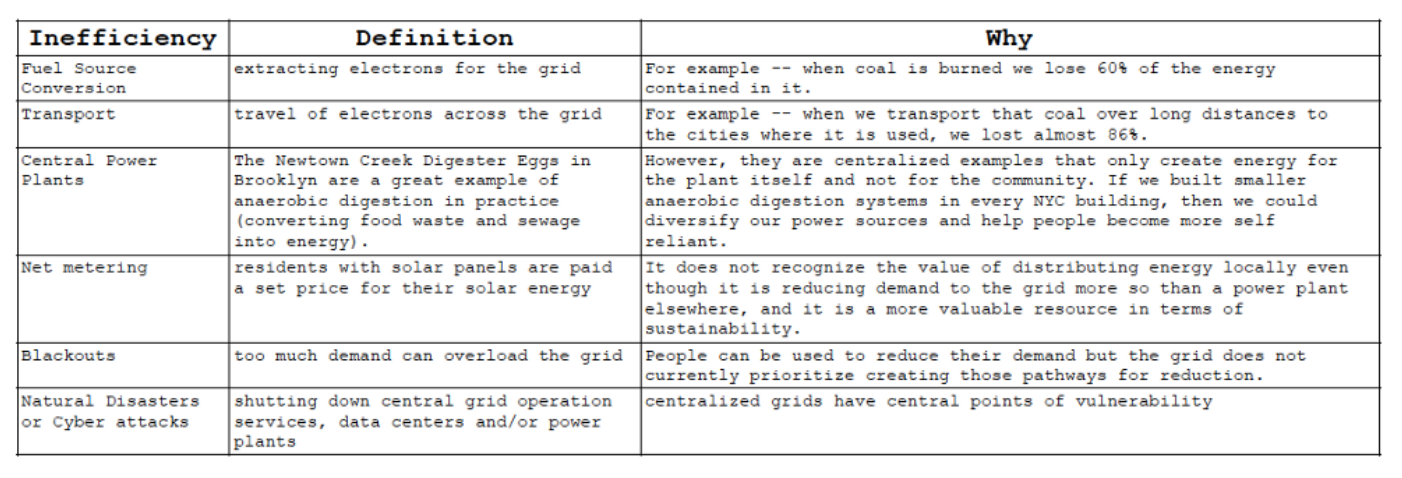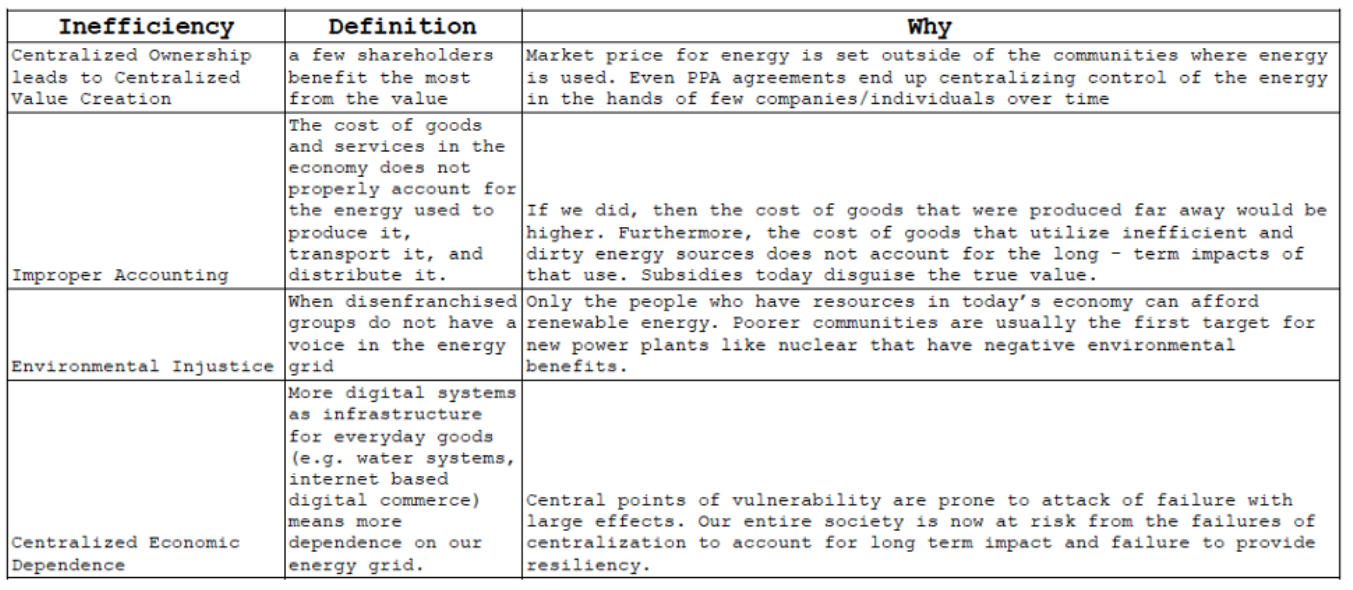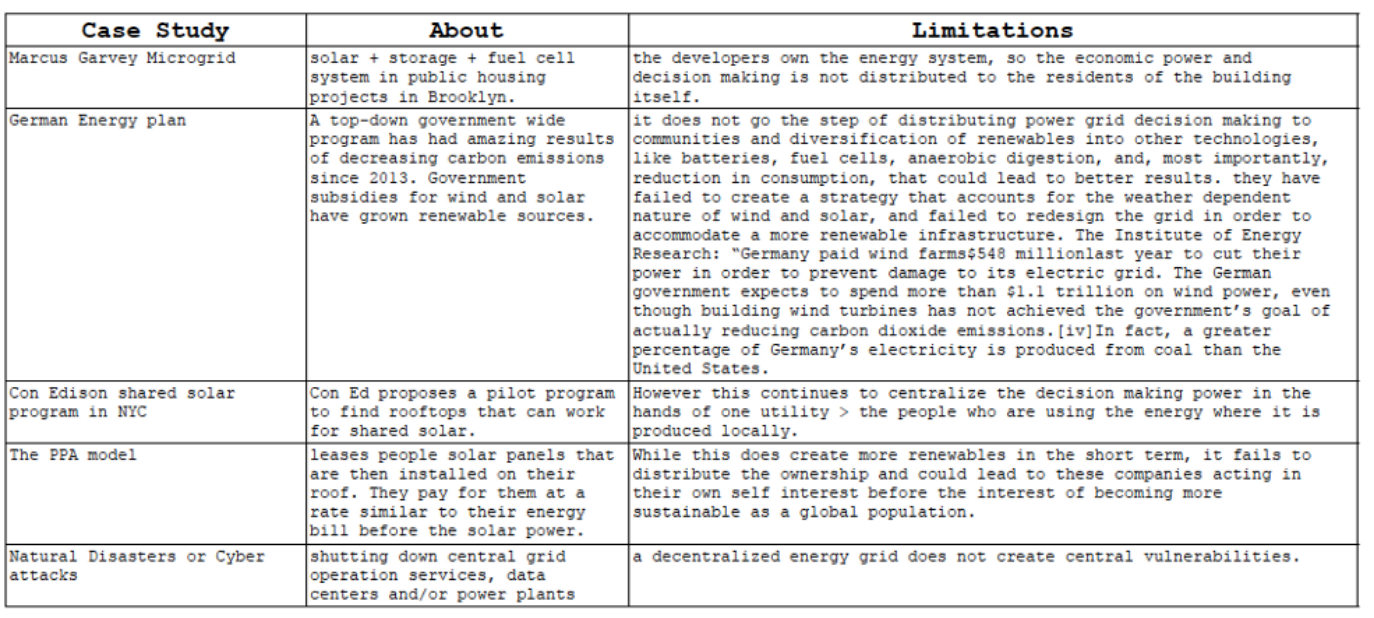Rationale for a Distributed Energy Transition
* Article: A Toolkit for Community Shared Power. By CooperativeCulture (Ashley).
URL = https://medium.com/@AshTayTweets/a-toolkit-for-community-shared-power-fef154347560
A great and simple explanation of why we need distributed energy, with useful overview tables and some examples.
Text
By CooperativeCulture:
"The centralized energy grid of today is moving towards a more decentralized architecture that distributes decision making to the grid edge, both technically and democratically.
In the current system, physical power is centralized in power plants where energy is produced far away from where it is consumed. Economic power is centralized in the hands of too few investors and grid operators who decide what kind of power is produced and the cost of it. For specific examples and case studies that explain these problems, see the grids at the end.
When we extrapolate into the future, a changing climate, increasing global population, and new distributed technologies like solar panels, battery storage, and demand response, all contribute to the necessity and possibility to redesign our power infrastructure and how we collectively determine the value of energy. There are many people working on projects that are implementing parts of the vision. However, there is a need to develop a more organized path for people, communities, businesses, and civil society to accelerate the process of shifting to a more sustainable system of producing and using energy.
The U.S.’s decision to leave the Paris Climate Agreement is a sign that we the people cannot depend upon federal government regulation to be the driver. Likely we should also not depend upon regulatory structures in general to be the primary force, as it will be subject to the political quagmire generated from the U.S. withdrawal.
We also cannot depend solely on industry to be the driver. On the surface it appears that oil and gas companies are now mobilizing around their solution to climate change. Exxon Mobile (the largest energy company in the world) and others are supporting a tax on carbon emitting fuel sources of $40-$80 per ton in exchange for lifting all government regulation on climate change. The money is then distributed to taxpayers as a carbon dividend at an average of $2k/year for a family.
But the problem with such solution is that it fails to decentralize the decision making power of the energy source equation. There is still too few companies that will be the deciders of what energy sources get funded and built into the future infrastructure, and there will be no public regulation that can serve as a safeguard for their decisions that might conflict with the goals of mitigating climate change especially for the most vulnerable populations.
Unless these companies shift their business models and corporate formations they will be responsible to shareholder value first before addressing the needs to transition the energy grid. They could end up funding an all renewable island that only the most wealthy can afford to live in and leave the rest of humanity to divvy up the last remaining coal plants. As Elon Musk says with the developments of SpaceX “a trip to Mars will soon cost you only $250k, and that’s little enough that anyone can save that much if they tried really hard.” Perhaps the carbon dividends could be saved up as a ticket to mars for the one lucky family member who draws a straw after waiting 125 years. Without distributing the economic ownership of the grid itself, then we will continue to encounter the same problems that come from designing for profit first rather than reforming the grid to meet the impending climate affair. We have seen thus far shareholder value tends to optimize for the needs of a small class of society and not for the planet’s global future. Continuing to adopt this business model then is deeply problematic if we are trying to build an infrastructure to mitigate against the mishaps of climate change and actually have a shot at creating a future built upon sharing, inclusion, and above all sustainability.
Rather than wait for an unlikely trickle down solution, we can mobilize around a better approach, which is distributing ownership, economic participation, and governance of the grid to the users of energy as much as the operators and investors of the grid system. By distributing the stakeholders in our power system, we can achieve a future that is more sustainable, more resilient, more productive, and ultimately more valuable. Over the next few weeks we will be releasing a path forward based upon what what we have learned in Brooklyn as a toolkit for other communities to adapt and implement their own version. We hope this can become part of a global knowledge and best practice sharing network of how we can reach sustainability quickly by reshaping the grid.
What is Working?
There are case studies of today that decentralize control — however they do not develop easy to implement replicable models with templates and toolkits. In Fukushima in the aftermath of the nuclear disaster, there is a company called Aizu power, which is “is a corporation run as a cooperative, with buy-in from local municipalities. Its goal is to empower locals to control their power generation options and gain income from Fukushima’s vast renewable energy resources. In nearby Tsuchiyu Onsen Village — the same village that saw tourist numbers drop to zero after the quake — a new, community-owned, geothermal plant is now providing energy to residents and others through the grid. …. With more than 40 villagers having invested in the project, making them all part owners. All the plants’ revenues return to the village, providing a new source of income. It has also become a tourist attraction due to its unique visible binary design.” — Originally Reported in Shareable.
There are also local examples of taking back control of the energy grid —
I attended a DC Solar Congress on behalf of Brooklyn Microgrid and learned about an energy cooperative there. These local models can eventually comprise a resource sharing network to accelerate the process for communities to implement their own versions that fit their local needs.
What we need, then, is a way for people to systematically engage with the process and build a movement for their local shift. I hope to hear about more examples and meet with activists that can work together on making the toolkit more robust." (https://medium.com/@AshTayTweets/a-toolkit-for-community-shared-power-fef154347560)
Visualization
Graphs via [1]:
Current Problems from Power Grid Centralization
Current Problems from a Centralized Energy Economy
Grid Reforms that fail to Decentralize Power
More Information
- author contact: Feel free to email me at ataylor@brooklynmicrogrid.com with suggestions


